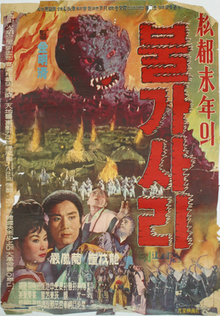| Bulgasari | |
|---|---|
 Theatrical release poster | |
| Hanja | 불가사리 |
| Revised Romanization | Bulgasali |
| Directed by | Kim Myeong-je |
| Screenplay by | Woo Beom |
| Adaptation by | Yun Beom |
| Produced by | Cho Yong-jin |
| Starring |
|
| Cinematography | Kim Yeong-sun |
| Edited by | Kim Myeong-je |
| Music by | Kim Yong-hwan |
Production company | Kwang Seong Films[1] |
Release date |
|
Running time | 110 minutes[2] |
| Country | South Korea[3] |
| Language | Korean |
| Budget | ₩3.5 million[4] |
Bulgasari at the End of Songdo,[a] or simply Bulgasari,[b] is a lost 1962 South Korean kaiju film[6] directed and edited by Kim Myeong-je. Produced by Kwang Seong Films,[1] it was the first monster movie to be made in South Korea,[7] as well as the first Korean film to use special effects.[8] It stars Choi Moo-ryong as Nam Hyeong / Bulgasari alongside Um Aing-ran, Gang Mi-ae, Kim Dong-won, and Lee Up-dong. In the film, a martial artist is resurrected as an iron-eating monster to exact revenge on those who murdered him.
Bulgasari was reported to have begun production on November 26, 1961. It was inspired by the legendary Korean monster of the same name and heavily influenced by Godzilla (1954). On an approximately ₩3.5 million budget,[4] Bulgasari began principal photography on February 28, 1962, and wrapped on March 24.
Bulgasari premiered at the Myungbo Theater in Seoul on December 1, 1962. The film received negative reviews from critics, especially because of its unconvincing special effects, direction, and acting. Believed to have disappeared shortly after its release, the film is considered a significant feature in the history of South Korean cinema and one of the most sought-after lost kaiju films. Shin Sang-ok directed a 1985 remake of the film during his abduction in North Korea.
- ^ a b "The Iron-eating Monster (Bulgasari)". Korean Movie Database. Korean Film Archive. Archived from the original on October 30, 2022. Retrieved October 29, 2022.
- ^ a b 통속적(通俗的)인 오락극(娛樂劇) 『불가사리』 (한(韓)) [Popular entertainment drama Bulgasari (Korea)]. The Chosun Ilbo (in Korean). December 7, 1962. p. 8. Archived from the original on May 19, 2022. Retrieved July 7, 2021.
- ^ Chung Beom, Ham. 1960년대 한국 SF 괴수영화와 동북아시아 영화 [1960s Korean sci-fi monster films and Northeast Asian films] (PDF) (in Korean). Hanyang University. Archived (PDF) from the original on August 13, 2021. Retrieved October 28, 2022.
- ^ a b "The Iron-eating Monster (Bulgasari)". Korean Film Archive. Archived from the original on March 7, 2016. Retrieved October 31, 2022.
- ^ 불가사리 [Bulgasari]. Korean Movie Database (in Korean). Korean Film Archive. Archived from the original on November 1, 2022. Retrieved November 1, 2022.
- ^ Bottenberg, Rupert. "Space Monster Wangmagwi". Fantasia International Film Festival. Archived from the original on July 25, 2022. Retrieved July 25, 2022.
- ^ Yeongjin, Lee (July 29, 2008). 한국 토종 괴수들이 몰려온다 [Native Korean Monsters Are Coming]. Cine21 (in Korean). Archived from the original on July 9, 2021. Retrieved October 30, 2022.
- ^ Heath, David (September 27, 2022). "8 Lost Films That Need to be Found". GameRant. Retrieved October 28, 2022.
Cite error: There are <ref group=lower-alpha> tags or {{efn}} templates on this page, but the references will not show without a {{reflist|group=lower-alpha}} template or {{notelist}} template (see the help page).